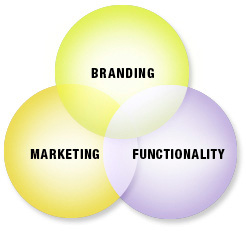The 3 Parts to a Healthy Online Presence
Ready to boost your SEO ?
The 3 Parts to a Healthy Online Presence
OVER THE YEARS, WE'VE COME TO REALIZE THAT WHAT WE DO FOR CLIENTS COMPRISES 3 PARTS.
And for a website to function properly, all 3 parts not only need to be implemented effectively, but also need to integrate well together. This is no small task and is rarely done well.
Part 1 - Branding
 Branding on the Internet is an amorphous term that contains many parts, such as: a logo, tag line, user interface (look + feel), messaging (headline copy), text, photos, graphics, video, illustrations, motion graphics, demos, information architecture, interactivity etc. All of which fall under the term the ‘User Experience’.
Branding on the Internet is an amorphous term that contains many parts, such as: a logo, tag line, user interface (look + feel), messaging (headline copy), text, photos, graphics, video, illustrations, motion graphics, demos, information architecture, interactivity etc. All of which fall under the term the ‘User Experience’.
This constitutes what is said, to whom and why it is said. Without the right message, to the right people, websites fail to meet their most basic task – communicate effectively to the target audience.
Typically the branding/user experience suffers because it is under too much pressure to serve too many interests. The ‘more is more’ rationale typically wins out. The best interfaces often are the ones where the content comprises the majority of the page and the ‘look + feel’ is secondary, minimal and simplified.
We focus on designing minimal, innovative and visually compelling user interfaces that place the content (what is said) at center stage. Our design philosophy emphasizes the message and content over gratuitous design elements to increase the impact of the page.
Part 2 – Marketing
The marketing component of a website is even more amorphous than branding, since it’s evolving and expanding into something very different than what marketing was originally conceived to be. So new terms have arisen such as ‘demand generation’, ‘inbound marketing systems’, ‘viral marketing’, ‘social marketing’, ‘content marketing’ and ‘search marketing’.
Nonetheless, the most common types of Internet marketing programs are: e-mail marketing, search marketing, pay-per-click advertising and social media marketing.
Regardless of the shifting sands of online marketing terminology and processes, websites suffer, if at least some of these programs are not effectively employed. They suffer in many ways, mostly from reduced traffic and decreased visibility on the Internet.
We focus on building sites that are highly visible, search optimized and effective at converting visitors into leads. Increasing conversion i.e. leads from websites, increasingly is what clients are looking for most and what we in turn look to specialize in more.
Part 3 – Functionality
Functionality here means interactivity, use of dynamic features and how well the site works. Are there any interactive features? Are there errors? Can you find what you are looking for? Is it easy to add pages, edit pages or add photos? How about self generated content or blogs or forums – does your technology platform include easy to add functionality? Is it software that has regular security patches and add on modules in the thousands?
There are many other parts to this as well such as technical problems with content that requires plug-ins such as video, audio and other assorted file types. Web 2.0 sites are typically built with software platforms such as Drupal and WordPress that enable advanced marketing, sales and content management features.
The key point to understand is that websites that are hard to use, hard to update, suffer from slow performance and lack interactivity, are problems not only in of themselves, but also adversely affect the branding and marketing components of websites.
For example, the easier it is to manage site content (e.g. create/edit a page in-house) the more pages will comprise a website, this in turn makes the site more visible to the search engines, which results in a higher page rank, which results in more traffic and hopefully increased leads and sales. This is why we specialize in Drupal, WordPress, Salesforce as well as numerous other open source and cloud applications.
Bottom Line
It’s a cliché but the whole is really greater than the sum of its parts, especially with websites. Understanding the different components and how best they integrate, is the first step to effectively realizing the value of a healthy website system. When we are able to effectively integrate these 3 parts for a client, we feel like we have succeeded and are grateful for the opportunity to put all that we have learned to good use.
with a Booster program for Healthcare companies.

